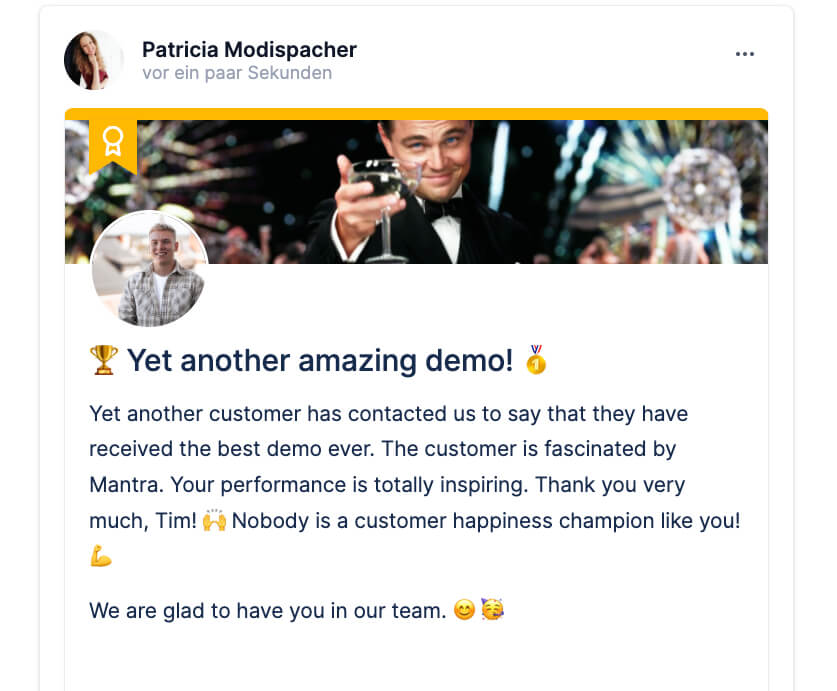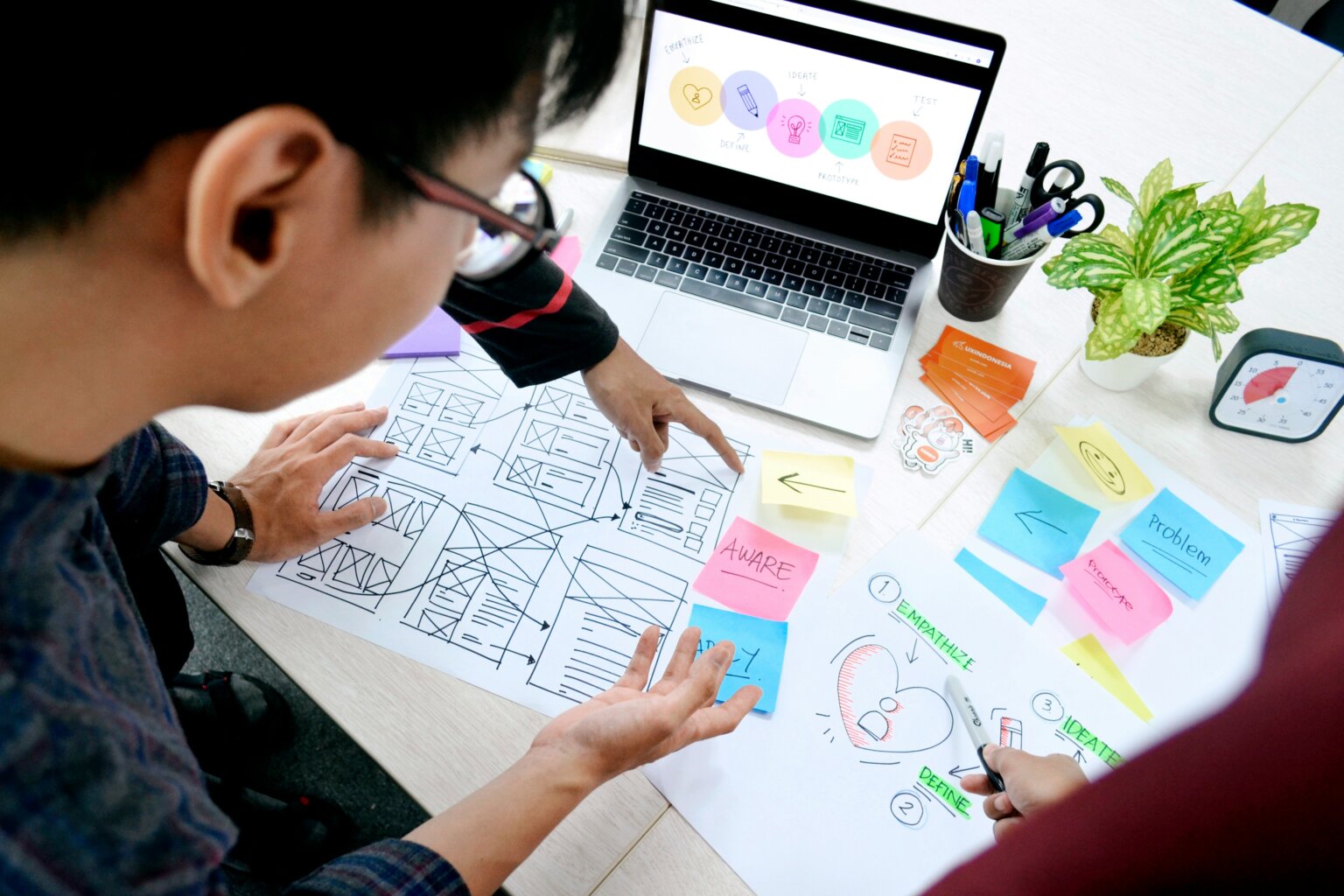How Design Thinking in the Workplace Sparks Innovation
Think outside the box. Think design. In this article, we’ll explain what design thinking is and how to implement it in your company.
Table of Contents
In a world where innovation is the key to survival, are you still relying on outdated problem-solving methods? Traditional approaches often fall short in addressing the complex challenges of today’s modern workplace. This is where design thinking comes into play.
Instead of focusing solely on the problem, design thinking takes a solution-oriented approach that puts the user experience first. This approach is in high demand, as it fosters creativity, innovation, and productivity.
Let’s now explore the key principles of design thinking, its benefits for organizations, and how it can be effectively implemented in the workplace.
What is Design Thinking?
Design thinking is a human-centered approach to problem-solving that draws inspiration from the design process. It’s a creative and iterative methodology that focuses on understanding user needs, challenging assumptions, and generating innovative solutions. Unlike traditional problem-solving methods that prioritize efficiency and logic, design thinking emphasizes empathy, experimentation, and collaboration.
The design thinking process is typically divided into five stages:
-
Empathize: This stage involves understanding the needs, wants, and frustrations of the people you’re designing for. By empathizing with your users, you can identify opportunities to create solutions that truly resonate with them.
-
Define: Next, you can begin to define the problem you’re trying to solve. This involves framing the issue clearly and concisely, identifying the root causes, and setting goals for your solution.
-
Ideate: This is the brainstorming phase where you generate a wide range of ideas for potential solutions. The goal is to encourage quantity over quality at this stage, as even the most unconventional ideas can lead to valuable insights.
-
Prototype: This stage involves creating tangible representations of your ideas so you can test them out. Prototypes can be physical or digital, and they should be low-fidelity enough to allow for rapid iteration.
-
Test: The final design thinking stage involves testing your prototypes with real users to gather feedback and refine your solutions. This iterative process helps you identify areas for improvement and ensure that your final product meets the needs of your users.
Keep in mind: design thinking is not a linear process, and it’s common to revisit previous stages as you learn more about the problem and your users. The key is to maintain a flexible and iterative approach that allows you to adapt to changing circumstances and new insights.

Benefits of Design Thinking in the Workplace
Design thinking unlocks countless benefits for your organization:
Innovation
Design thinking fosters a culture of creativity, encouraging you and your team to think outside the box and break free from conventional approaches. By focusing on user needs, it helps you develop targeted, innovative solutions that deliver real impact. Involving users early and often allows you to quickly refine ideas, reducing the risk of costly mistakes. By iterating on prototypes with user feedback, you ensure that your innovations are perfectly aligned with audience needs and primed for success.
Improving Collaboration
Design thinking creates a collaborative and inclusive work environment by helping team members understand each other’s perspectives. It brings together people with diverse backgrounds and skills, leading to more innovative solutions. Additionally, it promotes teamwork, builds stronger relationships, and improves team dynamics.
Streamlining Processes
Design thinking helps you streamline processes by focusing on user needs and identifying inefficiencies. By redesigning workflows to be more efficient, effective, and user-friendly, organizations tend to reduce costs and improve profitability.
More Effective Solutions
Design thinking shines when it comes to ensuring that solutions are thoughtfully crafted around the needs and desires of users, ultimately leading to greater satisfaction and effectiveness. Its iterative approach empowers organizations to constantly fine-tune and enhance their solutions by incorporating feedback and fresh insights. Moreover, it plays a crucial role in establishing clear goals and evaluating the impact of solutions to ensure they deliver significant value.

Design Thinking Techniques and Strategies for Businesses
Design thinking therefore has a number of advantages that are essential for every company. But how exactly can you implement it? Now, we’ll explain how you can revolutionize your workplace with the best practices:
Techniques:
-
Brainstorming: This classic technique involves generating a large number of ideas in a short period of time. Encourage participants to think creatively and avoid judging ideas prematurely.
-
User personas: Create detailed profiles of your target users to better understand their needs, motivations, and pain points. This will help you empathize with your users and design solutions that truly resonate with them.
-
Empathy maps: Visualize your users’ thoughts, feelings, actions, and pain points to gain a deeper understanding of their perspective. Empathy maps can be used in conjunction with user personas to create a more comprehensive picture of your target audience.
-
Storyboarding: Use storyboards to visualize your ideas and communicate them more effectively. This can help you identify potential problems and areas for improvement early in the design process.
-
Rapid prototyping: Create low-fidelity prototypes quickly and cheaply to test your ideas and gather feedback. This iterative approach allows you to refine your solutions based on user input.
Implementation
-
Build a design thinking culture: Foster a culture of creativity, (cross-team-)collaboration, and experimentation within your organization. Encourage employees to think outside the box and challenge the status quo. This will improve their overall employee experience as well.
-
Provide training and support: Offer training programs to educate employees about design thinking principles and techniques. Provide ongoing support and mentorship to help teams apply these concepts to their work.
-
Create a dedicated design thinking team: Consider forming a dedicated design thinking team to lead and facilitate design thinking projects. This team can provide expertise and guidance to other teams within the organization.
-
Use design thinking tools: There are many online tools and software applications that can support the design thinking process, such as mind mapping tools, collaboration platforms, and prototyping software.
-
Celebrate successes: Recognize and reward teams for their achievements in applying design thinking. This will encourage others to adopt a design thinking mindset and contribute to a culture of innovation.

How Leading Companies Use Design Thinking
Many organizations across different industries have embraced design thinking to drive innovation and solve complex challenges. Let’s look at two standout examples:
Netflix
Netflix, the global streaming giant, has consistently used design thinking to drive innovation and stay ahead of the competition. One of the key factors behind Netflix’s success is its ability to listen to customer feedback and respond with innovative solutions.
-
DVD rental revolution: Netflix disrupted the traditional video rental industry by offering a convenient subscription-based service that delivered DVDs directly to customers’ homes. This innovation was driven by a deep understanding of customer needs and a desire to eliminate the inconvenience of physical stores.
-
On-demand streaming: As DVDs became outdated, Netflix pioneered on-demand streaming, providing customers with access to a vast library of movies and TV shows at their fingertips. This move demonstrated Netflix’s ability to anticipate market trends and adapt to changing consumer preferences.
-
Original content: Netflix further differentiated itself by producing high-quality original content, catering to the evolving tastes of its audience. This strategy was based on customer insights and a desire to offer unique and exclusive programming.
UberEats
UberEats, the popular food delivery platform, has also leveraged design thinking to improve its services and enhance the customer experience.
-
Immersive research: UberEats conducts in-depth research to understand the specific needs and challenges of customers and delivery partners in different cities. This research helps them identify pain points and develop targeted solutions.
-
Driver app innovations: Based on their research, UberEats has implemented several innovations in their driver app, such as providing step-by-step directions and optimizing routes to improve delivery efficiency and reduce driver frustration.
-
Customer-centric focus: UberEats consistently prioritizes customer satisfaction by offering features like real-time order tracking, easy payment options, and a variety of cuisines to choose from.

Implementing Design Thinking in Remote and Hybrid Work Environments
With the right online collaboration tools, design thinking fits perfectly into remote and hybrid work setups. Creating an atmosphere of trust, flexibility, and independence helps teams thrive, wherever they may be working.
Key Strategies for Remote and Hybrid Design Thinking:
-
Foster autonomy and flexibility: Give your team the freedom to work independently and choose the setup that suits them best. This can lead to higher productivity, greater job satisfaction, and a stronger sense of ownership over their work.
-
Promote trust and collaboration: Build a culture where trust and teamwork thrive, even when working remotely. Break down communicaiton barriers, foster open communication, live knowledge sharing, schedule regular check-ins, and organize virtual team-building activities to keep connections strong.
-
Leverage online collaboration tools: Tools like Confluence are invaluable for managing design thinking projects. They offer a central hub for sharing information, fostering discussions, and tracking progress, making collaboration easy and efficient.
-
Prioritize organization and communication: Make sure everyone is on the same page by setting up clear processes and communication channels. Confluence integrates seamlessly with tools like Jira and Trello, helping to streamline project management and keep things running smoothly.
-
Encourage regular feedback and iteration: Create opportunities for team members to share feedback and refine ideas – keyword here is feedback culture at work. This ensures that solutions are closely aligned with user needs and effectively address the challenges of remote and hybrid work.
For all these strategies and steps, a good internal communicatin plan is key.

Ready to Become a Design Thinker?
In this article, you’ve learned about the key steps and strategies involved in design thinking. Now, it’s time to put this knowledge into practice!
Design thinking is a versatile framework that can benefit you and your team. By focusing on user needs, fostering creativity, and encouraging collaboration, you can drive innovation, improve efficiency, and enhance customer satisfaction.
Explore the benefits of Confluence today and see how design thinking can transform your workplace.
Supercharge your Confluence
Let’s create something extraordinary together
Schedule a free consultation with our team and let’s make things happen!
Book a demo

Sup dudes! Easy a55gamedownload process, I gotta say. No hassle, straight to the action. Check it out yourself: a55gamedownload
Hey gamers! 888slotapps is where it’s at if you’re looking for some mobile fun. Downloaded the app and instantly got hooked. Simple to use with tons of options. Definitely worth checking out. 888slotapps